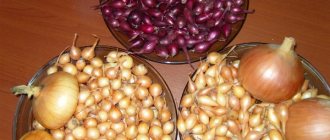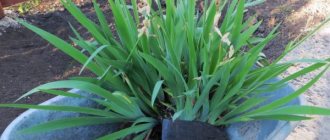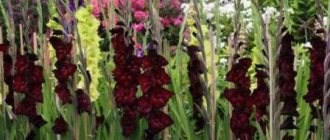Botanical description of beans
Beans are annual vegetable crops. Their botanical features:
- Stem. Straight, tetrahedral, thick, reaches a height of 30-120 cm. Branches weakly.
- Leaves. They have a complex structure, consisting of 3-5 leaves.
- Root. Powerful, goes 1.5 m deep.
- Inflorescence. Racemes with 4-14 flowers in white, yellow, blue or brown. There are black spots on the wings.
- Fruit. The pods are long and can be straight or curved. Length – 4-20 cm, depends on the variety. The valves are green at the stage of technical ripeness and darken as they ripen. The pod contains seeds, in quantities of 2 pieces. Color, shape and size are determined by the variety. They are yellow, green, purple, brown, black, and variegated.
Bean varieties differ in terms of ripening, yield, fruits, plant height, and agrotechnical characteristics.
The process of planting peas for seedlings
To get a very early harvest, peas are sometimes grown through seedlings. True, a lot of space in the apartment must be allocated for this, so they try to prepare seedlings in greenhouses or greenhouses. Any containers in which seeds are sown every 2–3 cm are suitable for this purpose. The composition of the soil does not matter. For sowing, it is better to use early varieties, for example, Early 301 or Viola.
Since there is no need to be afraid of cold weather at home, peas are soaked for 10–12 hours before planting, changing the water periodically. Sowing the seeds itself is not difficult: they are buried to a depth of 3–4 cm, having previously marked frequent grooves, and watered well. Peas sprout in about a week, and seedling care is as simple as keeping the soil moist and monitoring light and temperature conditions. Peas should be in the sunniest place with a temperature no higher than 20 ° C.
The most difficult thing is picking the seedlings, so you can immediately sow them in separate cups, but in the apartment there will certainly be nowhere to put them. In this regard, they often do without picking, but untangling the intertwined roots of neighboring plants is not at all easy.
With this option, the snail should be illuminated for at least 18 hours a day. After two weeks, the seedlings develop good roots, and after a few more days the “snail” is unwrapped, the peas with roots are carefully separated and transplanted into a garden bed.
Already at the stage of cotyledon leaves in toilet paper, peas produce powerful roots
Transplanting seedlings into the ground
Seedlings in a box with soil are ready for planting in 3–4 weeks, earlier in hydroponics. Carefully removing it from the nursery, plant it in pre-prepared beds. In the middle zone this is done in the first half of May, in the south - at the end of April.
The seedlings are planted in deep furrows, well watered. Planting pattern: 10–12 cm in rows and 35–40 cm between them. If the work is carried out in cloudy weather, the seedlings take root well.
The best varieties
Beans, when compared to other garden crops, do not have many varieties, although their history goes back thousands of years. All varieties are divided into 4 groups according to ripening time:
- early - 60-65 days pass from germination to the first ripe pods;
- mid-early – 65-75 days;
- mid-season – 70-90 days;
- late - about 100 days.
Also, all beans are conventionally divided into two types of varieties:
- Northern. They are characterized by early ripening, increased frost resistance and undemandingness. For regions where summers are short and cool.
- Western European. For the southern and central regions of the country, where the climate is warmer.
Velena
Mid-early sugar variety, ripens in 90 days. The height of the plant is up to 1 m. The length of the pods is 12 cm, each with 4 beans. The fruits are round, pale white, then light fawn. Productivity 1.1-1.7 kg per 1 sq. m.
Belorussian
Tall, mid-season beans. Plant height is 1-1.4 m. One plant produces up to 6 pods. They ripen approximately 70 days after germination, and harvesting occurs after 100 days. The pods are large, not curved, each contains 3-5 fruits, tasty, juicy, fleshy. One of the most common varieties in Russia. From 1 sq. m harvest 0.5 kg of beans.
Virovsky
Mid-season variety. The ripening period to full technical ripeness is 95-102 days. The pods are slightly curved, length – 8-9 cm. The fruits are oval, whitish or lemon yellow, matte. Excellent taste during milky ripeness. Productivity – 0.56 kg per 1 sq. m.
Aushra
Fodder grade. Ripens in 120 days. The pods are 6-8 cm long. There are 3-4 beans in the pods. Drought resistant. Productivity – 29 c/ha, green mass – 340 c/ha.
Russian blacks
Mid-early, frost-resistant variety. It has a pronounced sugary taste. The plant is branched, 0.6-1 m in height. The pods are small - up to 8 cm, containing 3 beans. The taste of the fruit is delicate, juicy, sweet. By the time of technical ripeness, the seeds are light green; when fully ripe, they turn purple.
They prefer to grow in sunny areas. From 1 sq. m collect 0.5 kg. This is an old proven variety, bred in the USSR and officially registered in 1943.
Bobchinsky
Mid-early sugar variety. It takes 60-65 days from germination to technical ripeness. Plant height – 0.6 m. Pods are straight or slightly curved. Productivity 1.3-1.6 kgf 1 sq. m.
Windsor White
High-yielding variety with medium ripening periods. Brought out in Europe. It has performed well in harsh climates and can withstand spring frosts. The plant is tall, the height of the shoots is 1-1.2 m. The pods are large, fleshy, with a smooth surface. Each pod contains 2-3 milky green beans. As they ripen they turn brown.
The taste of beans is excellent, they contain a lot of vitamins A, B, C. They are very high in calories - many times higher than potatoes. Productivity – 1.6-1.8 kg per 1 sq. m.
Patio
This variety ripens earlier than others. Its main difference is its compactness. The height of the plant is no more than 30-40 cm. The variety is suitable for growing in pots - such beans can be grown on balconies and patios. The bushes quickly grow greenery; the ovaries ripen 50 days after planting. There are up to 8 fruits in one pod. The taste is pleasant, eaten during milky ripeness. Suitable for recycling. Harvesting is in July-August.
Pink flamingo
The variety belongs to the new category. Ripening dates are mid-early. It takes 60 days from germination to technical ripeness. The plant grows up to 60 cm in height. There are 8-16 pods on one bush. They are light green in color. The length of the pods is 7-8 cm.
The advantage of this variety is that the pods do not crack after ripening. The seeds are large, carmine pink. Tasty fresh and suitable for various types of processing.
Childish delight
Mid-early variety. Ripens in 70-90 days. The plant is of medium foliage, height is about 1 m. The pods are wide, strongly curved, and green in color during the period of technical ripeness. The seeds are large, oval-shaped, white.
Beans repel Colorado potato beetles and moles.
Optics
An early variety, ripens in 88-100 days. Powerful plant, grows up to 1 m in height. The pods are large, fleshy, with thick leaves. Length – 10-15 cm. One pod – 3-4 seeds. The color of beans at milky ripeness is light green.
Once ripe, the seeds turn dark beige. Tasty fresh, suitable for canning, freezing, and culinary processing. The variety is recommended for dietary nutrition.
Royal Harvest
Mid-early, highly productive variety. An erect plant with fleshy and long pods. The fruits are large, there are as many as 8 of them in one pod. It is distinguished by uniform ripening and high taste characteristics.
Summer resident
Tall, early ripening variety. Grows more than 1 m in height. The pods are large, the valves are fleshy. The length of the pods is up to 17 cm. The seeds are large and white. Recommended for children's and dietary nutrition.
White pearls
The variety was recently released. The pods are peeling. From germination to technical ripeness – 55-65 days. Height – 1 m. On one plant – up to 10 pods, straight and long. The length of the pod is up to 11 cm. Each pod contains 4-5 fruits. At first, the seeds are light, when ripe, they turn yellow, and during storage they acquire a light brown tint.
How to germinate seeds, beans and grains
Many people are interested in how to germinate beans. To do this, you need to perform a series of sequential actions.
Bean selection
First you need to select the beans. Any variety can germinate, but experts advise using the smallest ones. Large types of beans are prone to mold growth when exposed to high humidity for a long time.
First you need to select the grains
Germination in a jar
To get sprouted beans this way, you need to do the following:
- Take a clean glass container.
- Wash the beans.
- Place the grains in a jar, filling it one-fifth full. You should not take too many beans, as this may cause the development of bacterial microorganisms or fungi.
- Add water at room temperature and cover with a mesh lid. Instead, you can use natural fabric.
- Place the container in a dark place for 8-10 hours.
- Then drain the water and rinse the beans. This procedure should be repeated twice a day.
The first shoots should appear within a few days. When they grow to 3-8 cm, you can remove these fragments. They should be placed on a clean napkin and left to allow excess moisture to evaporate.
You can use jars to sprout legumes
Germination under pressure
You can use a press to sprout beans. To do this, it is recommended to do the following:
- Rinse half a glass of beans in cool water. This will help remove contaminants and get rid of bacteria.
- Place the beans in a small container and cover with cool water.
- Drain and rinse beans.
- Place a napkin in the bottom of the colander and place the beans on top.
- Cover the top with another clean napkin. Pour water over it.
- Place a colander in a small bucket and place a bag of small stones on top of the beans. Its weight should be 1.5-2.5 kg.
- Place the container in a dark place. If this is not done, the beans will acquire a green tint and a bitter taste.
- The napkin needs to be changed every 3 hours.
- When the sprouts reach 2.5-8 cm in length, they need to be removed. Then place these fragments on a clean surface and dry.
Features of cultivation
Beans are the most cold-resistant garden crop. Its cultivation requires a certain temperature and humidity:
- Beans are plants with long daylight hours and are undemanding to thermal conditions. They germinate at 3°C and can withstand frost down to -4°C. Seeds sprout at 3°C. They sprout after 12-13 days.
- Temperature for growth – up to 21-23°C. Beans don't like heat. At high temperatures, the flowers fall off and many barren flowers appear.
- The culture is moisture-loving. Watering is especially important during the flowering period. Does not tolerate drought well.
- Beans make the soil loose and prevent weeds from growing.
Reviews about growing peas at home
It will grow, but it will not please you with the fruits: there are no conditions for this in the apartment. The best option: germinate peas in wet gauze and eat them along with the roots on day 3-4. At the moment of germination, all substances in all seeds are maximally activated, and this works for our immunity. Good luck! Hello!
Elena Madyka - Trukhina
Earth, a pot, you can do it without a lamp - peas are a tenacious plant. Don't forget to water.
Dmitriy
As you can see, growing peas at home is not difficult, and you can completely cope with this task, even if you are starting it for the first time. Follow all instructions regarding growing seedlings and agricultural technology, and you will be able to get a fresh harvest at any time of the year.
kak.manesu.com
Broad beans are also known as faba beans, green beans, Windsor beans, and the most popular name is garden bean ( Vicia faba
). In fact, these are peas, a type of vegetable that originates from Western Asia. Beans prefer cool weather and enjoy plenty of sun, but are an excellent source of protein and vitamins A, C and B, rich in fiber and delicious. They are definitely worth growing in your garden. You can learn to grow, care for, and harvest broad beans. Start with step 1.
Part 1 Planting broad beans
- 1 Select the type of broad beans you will grow. There are many types of broad beans available, some of them are not very demanding, while others depend directly on the space you allocate for them. Whether you want to grow broad beans in your kitchen window sill or in a greenhouse, this is the plant for you. Here are some great and hardy varieties:
- Dwarf beans (Sutton) grow only about 12 inches (30 cm) tall, making them great for small vegetable gardens, greenhouses and other places where space is a concern.
- The Imperial Green Longpod bean variety produces huge, 15-inch (37.5 cm) long pods with several large beans each, prized for their flavor.
- The Stero variety is a compact plant that bears fruit well with regular harvesting and produces beans so sweet that they can be eaten raw.
- Red Epicure produces bright red beans, offering a unique and exotic alternative to regular kidney beans and fava beans.
- The Aquadulce Claudia variety has been grown since around the 1850s and is loved for its bean flavor and hardiness. This variety is well suited for growing in winter and late autumn.
- 2 Select a planting date for broad beans based on your climate type. Depending on where you live, you can plant broad beans in late fall after you've cleared your entire garden of summer crops, so you can harvest in the spring, just before the new gardening season begins. In regions with very cold winters, however, wait until spring.
- Temperate Zones: In most regions, it is best to plant beans in early spring for a late summer harvest. Broad beans prefer temperatures of 60 - 65 F (15-18 degrees C), and suffer at temperatures above 80 F (27 C).
- Warm Mediterranean climate: Plant during mild winters. Beans can thrive in temperatures around 15 degrees F (-9 degrees C), so they are an excellent candidate for overwintering in some regions. Because of their long ripening period, planting broad beans in late fall will ensure you have an early spring harvest.
- Cold or very hot areas: Grow seedlings indoors in regions with sudden temperature swings. If you live in a highly continental climate, the transition from winter to summer can be sudden, which can kill the young shoots of most legume varieties, so it's best to start the beans indoors first and then transplant the plants outdoors after a few weeks.
- 3 Fertilize the soil. Wherever you grow your beans, plant them in loosened soil that has been amended with the fertilizer of your choice. Since broad beans release nitrogen as they grow, they do not need to be fertilized. But if you apply fertilizer, use one with a reduced nitrogen content.
- Choose a place in the sun, away from bulbous plants, loosen the soil to a depth of several centimeters, add compost.
- 4 Try inoculating the seeds to stimulate growth. Broad beans can grow in any type of soil and are a self-fertilizing crop. But to help them absorb nitrogen, you can nevertheless use a nodule bacterium of the genus Rhizobium, this will increase the ability of the roots to retain nitrogen and stimulate plant growth. This black powder is available at any garden store.
- Lightly moisten the seeds and place them in a coffee jar or cup of inoculum, then shake gently to coat the seeds evenly with the powder before planting. Do this a few minutes before planting the seeds in the soil.
Part 2 Caring for broad beans
- 1 Prop the plants as they begin to grow. Small bean bushes quickly begin producing heavy pods, and without proper vine support the plants will fall over and sag. Therefore, it is important to install stakes along the row of broad beans, and use them to support the plants as they begin to gain weight.
- Place small poles a foot or two apart (30-60 cm) along the row, with string between them to give the plants something to grab onto. You can use twine or ribbons from old sheets to tie the plants neatly and keep the pods off the ground rather than on it.
- Don't wait for the plant to become huge and spread across the ground. It is very easy to damage the roots and grow mold on the plant if the vines spend too much time on the ground.
- 2 Water moderately and deeply. Broad beans can withstand drought, but be sure to keep them well watered, especially if you live in a hot climate. Moisten the soil deeply during the coldest part of the day - either early in the morning or in the evening after dinner, but do not overwater the beds. There should be no water standing in the rows of beans.
- Avoid overwatering; do not pour water on top of the plant so that it flows into the soil. This will lead to mold and other problems. Water the soil directly.
- 3 Actively control weeds, especially if you are preparing beans for winter. Broad bean roots are relatively shallow, making it very easy to accidentally uproot the plant if you overdo it with the hoe. Remove weeds around bean bushes by hand, keeping the area clean. Once the plant is well established, you can be a little easier on the weeds.
- 4 When the plant begins to produce pods, prune new shoots. The plant will continue to grow and produce too much if you don't pinch back new shoots at the top of the plant as soon as you see the first pods. Here you can even harvest the young leaves, which can be used as salad greens (they have a surprisingly delicate flavor).
- Trim off the growing tops when you see young bean kernels at the base. Remove the top with two leaves. If you don't want to use them for food, turn them into fertilizer.
- 5 Consider using a sprout control strip. If you have problems with rodents, groundhogs, rabbits or other animals that make a mess of your garden, you should cover your broad beans with a strip cover. Strip sprout protection - plastic or fabric sheets that are carefully placed over the plants. They leave plenty of room for growth and air circulation, and also keep you warm.
- Strip seedlings are also great if you are planting in the fall, as this will help keep the heat closer to the ground and protect the plants from frost.
- If you use strip covers, leave the rows uncovered at least during the middle of the day, at least while you remove weeds, to allow more open air circulation. Look for fungal infestations and wet rot at the plant roots. If you see whitish or yellowish patches, reduce watering and give the plant more air.
- 6 Beware of aphids. Aphids love legumes and usually congregate on the tops of plants, near new shoots and buds. Some gardeners like to use an insecticidal spray to remove aphids from their plants, but an easier method is to trim off parts of the plants where you see aphid conglomeration. If you are diligent enough, you can trim off aphids before they damage the plant.
Part 3 Harvesting broad beans
- 1 Harvest part of the crop early so you can eat it all. Like other varieties of bush beans, broad beans can be tender and edible in the first few days after they form, eaten like sugar snap peas, or stewed and served as a side dish. Broad beans have a waxy outer shell, but when harvested from young beans, the shell is still tender and edible.
- Look for narrow, bright green pods. The pods should be thin and narrow, with mature beans visible through them. If the beans are visible, allow them to ripen completely.
- Don't go overboard with harvesting young beans if the plant has not produced as many pods as you planned to harvest. You can pick a few from each plant if you can't wait, but save most until they are fully ripe.
- 2 Harvest mature beans when the pods are light in color and not too swollen. Broad beans are ready to harvest when the pods are full and the beans are full and clearly visible in each pod. The pods first fill up and then begin to bend under the weight of the seeds when they are ready for harvest.
- Depending on the variety you grow, the pods can be 6 to 15 inches (15-37.5 cm) long, with several large, full beans inside, and there are usually several pods per plant. If you harvest them regularly throughout the season, you give the plant the opportunity to produce fruit again and again as weather permits.
- 3 Peel the beans. To get broad beans, you need to de-pod them. Holding each pod with the pointed end facing up, pull the strips on each side to open the pod.
- Again, depending on the variety, each pod may contain 5-10 large beans, encased in a thick waxy shell that must be removed before eating. It takes some work, but if you're organized, you'll get the job done fairly quickly.
- The easiest way to do this is to blanch them by placing the beans in boiling water for five seconds, then immediately remove them with a slotted spoon and place them directly into the ice water. This will loosen the shell on each bean.
- 4 Enjoy beans in soups, salads and other dishes. The best way to consume broad beans is also the simplest: simmer and serve with salt and pepper. They are large, filling and tasty and go perfectly with red meat. They also make an excellent base for bean soups or as an addition to nutritious salads.
- 5 Return any remaining plant to the soil when you harvest. Since broad beans are excellent nitrogen producers, it would be good to return them back to the soil and thereby enrich it with these components. Cut each plant off at the base and bury it. Cover them with soil and next year plant in this place those crops that need nitrogen fertilizers.
Planting in open ground
Beans are an unpretentious crop. If you properly prepare for planting, the likelihood of a high harvest increases many times over.
Preparing the soil for planting beans with seeds
Soil preparation procedure:
- The earth is dug up on the bayonet of a shovel. In the fall, add compost or manure - 3-4 kg per 1 square meter. m. Ash is also added to the soil to reduce the acidity of the soil.
- In the spring - re-digging. During spring digging, mineral fertilizers and 15 g of urea are applied.
When to plant seeds?
Beans are sown as favorable weather conditions develop - the soil should warm up, at least to +5°C, and at the same time be sufficiently moist, filled with melt water. In central Russia, this time comes in early May. If you delay planting, the growth and development of the plant will be less intense. Late planting leads to damage to the crop by fungal diseases and insects.
The seedling method is rarely used. It allows you to bring the harvest closer, but requires extra hassle. This option is used in regions where spring comes late.
Procedure for growing seedlings:
- Soaking seeds for 12-14 hours.
- Planting in separate containers. Disembarkation time is early April. They grow seedlings in a greenhouse for about a month.
How to increase seed germination?
Preparing seeds for planting:
- Seeds for sowing are carefully selected, rejecting defective and non-standard ones. If there is a hole in the bean, it is also set aside - it has been damaged by the grinder. If you break the seed in half, you can see that a larva has settled inside. Such seeds are not suitable for planting.
- Seeds are germinated at 4-10°C. To do this, they are wrapped in damp cloth for 1-2 days. You cannot wet the material too much - the seeds will rot and not germinate. The beans are placed on one moistened piece of cloth and covered with the other. The second germination option is to place the seeds in a plate of water for 5-6 hours. The beans are soaked in the stimulator for 4 hours. Seeds should not be kept in water or stimulants.
Planting methods
Planting beans with seeds in open ground can be done in two ways:
- Wide row single line. Leave 40-45 cm between rows. 20-25 cm between adjacent plants. The distance should be such that the beans do not interfere with each other’s growth.
- Tape two-line. The distance between ribbons is 45 cm. Between lines is 20 cm, between bushes is 10 cm.
The seeds are buried 6-8 cm. The sowing rate is 25-35 g per 1 sq. m. m. The seeds are planted in moist soil, but after planting it is still watered.
The best neighbors for beans
The crop in question gets along well with many vegetables. Beans can be planted near tomatoes, corn, radishes, radishes, spinach and mustard. But their best neighborhood is with cucumbers. It is recommended to plant beans around cucumber beds.
Beans are also compatible with potatoes, but they are planted exclusively around the perimeter of the plot - so that they do not take away nutrients, the beans are very “gluttonous”. If you plant beans between rows, the tubers will grow small.
For the beans themselves, proximity to herbs is beneficial - they grow excellently next to basil, lavender, oregano, rosemary, and yarrow. Contraindicated as neighbors are onions, garlic, peas, marigolds and wormwood.
Choosing a site for planting beans
Beans grow best on loose loam with a slightly alkaline or neutral reaction. Even in soil with few nutrients, these undemanding plants can produce a decent harvest if they have enough potassium. If there is a deficiency, wood ash or other organic matter is added to the soil before planting.
There are other conditions that need to be taken into account when choosing a site for growing beans:
- the place should be open and bright, located on a slight hill;
- the duration of its illumination by the sun is maximum;
- too wet soil in a cold lowland will not work;
- Excess nitrogen in the soil negatively affects plant development.
When growing beans, it is necessary to strictly follow the rules of crop rotation.
They cannot be planted in beds where soybeans, peas, lentils, beans and other plants belonging to the legume family grew in the previous season. During development, they actively produce nitrogen-containing substances, and beans do not tolerate their excess well.
When properly planting beans and caring for them in the open ground, you need to take into account the influence on their development of the crops that grew in this area before. The best predecessors for vegetable beans are tomatoes, cucumbers, cabbage or potatoes.
But experienced gardeners do not recommend planting potatoes and beans in the same hole or nearby. For the normal development of both crops, a lot of potassium is required. But due to the faster growth of beans, potatoes lack it. The root system of legumes “supplies” nitrogen to the soil, and the grown shoots shade the lagging potatoes, in which, due to lack of lighting, tops, rather than tubers, begin to grow intensively. The yield loss in this case can be significant. When planting beans together with other crops, they are planted around the perimeter of the beds or area with potatoes.
Caring for garden crops
Caring for beans is simple - they need to be watered, loosened, hilled, fed and weeded in a timely manner.
Feeding beans
If the soil has been properly prepared - organic and mineral fertilizers have been applied, then there is no special need for fertilizing. If some points were missed when preparing the soil, the plant’s appearance will indicate a problem - it may need feeding.
Features of feeding beans:
- During the emergence of seedlings, the crop is fed with urea and mullein, 20 g and 0.5 l per 1 square meter. m respectively. The components are dissolved in 10 liters of water and the resulting solution is watered over the beds - 0.5 liters per bush.
- For 1 sq. m, 10 g of superphosphate, 5 g of potassium salt and ammonium nitrate are introduced.
If the beans have slowed down in growth, they are fed with potassium-nitrogen fertilizer - 10-15 g are added per square meter.
Features of watering
Beans love moisture, and regular hydration is an important point in the agricultural technology of this crop. Watering is recommended during flowering and during fruit set. But it is important not to overdo it with watering - if moisture stagnates, the roots of the plant may rot. Another disadvantage of excess moisture is the active growth of greenery to the detriment of yield.
If there is no rain, then the beans are watered 2 times a week. For 1 sq. m pour about a bucket of water.
Weeding, loosening
Since the plant has a powerful root system, it suppresses the growth of “strangers”. Weeds that do grow must be removed so that they do not interfere with the growth and development of the crop. This is especially important at the initial stage, when the plant grows, suppresses competitors, and the need for weeding disappears.
When the height of the plants reaches 50 cm, they are hilled. During the season, 2 hillings are carried out. By raking the soil towards the stem, the plant better resists the wind.
Pinching the tops
Pluck the tops when the flowers appear. Aphids adhere to young greenery and drink the juices. By tearing off approximately 10-15 cm of the tops, the gardener deprives the parasites of their “food base”. At the same time, the fruits develop and ripen evenly.
Tying, creating support for shoots
There are varieties of beans that reach a height of 1 m or more. Such plants can break under the influence of the wind - the stems of the beans are quite fragile. Tall varieties need to be tied up.
The following types of supports are used for tying:
- Wooden supports - they are driven into the ground near the bush. The plant is tied to a support with soft twine. The height of the stakes is 1 m.
- Trellis. To build them, posts are driven into the edges of the bed. Between them there is a soft cord to which the stems are tied.
How to deal with pests?
In order not to lose the harvest, plantings with dangerous insects are treated with special compounds.
Bean pests and their control:
| Pest | Harm | Treatment |
| Black bean aphid | It attacks young shoots, causing the stems to become crooked. | Cutting off the tops during active growth - up to 15 cm long. Treated with Karbofos. |
| Bean weevil | The butterfly lays eggs in young ovaries. The larvae, having penetrated the seed, eat it away. | Soaking seeds in a salty solution. |
| Sprout fly | Fly larvae feed on bean roots. | Regular loosening of the soil and removal of weeds. |
Disease Control
Beans rarely get sick; this crop is disease resistant. But preventive measures will not hurt; any disease can lead to loss of the harvest - all or part.
Common bean diseases and their symptoms:
| Disease | Symptoms | Treatment |
| Anthracnose | Brown spots appear on leaves and stems. The bean leaves are darkly ulcerated, the formation of fruits is disrupted. | Spraying plants with 1% Bordeaux mixture. |
| Rust | A fungal disease causes changes in plant tissue - stems and leaves turn white and soften. Grows in damp climates. | Agrotechnical methods are used - fertilizing and seed treatment. |
| Powdery mildew | Symptoms appear during flowering. All above-ground parts of the plant have a white coating. Lasts throughout the growing season. | Treatment with 1% sulfur colloid (0.50 g per 1 sq. m). Pollinate with powdered sulfur (3 g per 1 sq. m). |
Prevention measures:
- Application of potash and phosphorus fertilizers.
- Destruction of plant residues after harvesting.
- Warming the seeds before planting in water +50 °C.
When to plant beans in Siberian conditions
The continental and sharply continental climate of Siberia is quite harsh, even despite all the changes that have been taking place throughout the planet recently. Peas and beans in Central and Eastern Siberia should be planted in open ground in the second ten days of May, when there is no longer any danger of return frosts. It is better if the predecessors are pumpkin or nightshade plants - eggplants, tomatoes, capsicums, potatoes.
Planting and caring for beans in open ground is carried out everywhere. Dry seeds are usually planted. But in especially cold years, they use the seedling method - they grow seedlings in peat pots. The distance between nests is at least 10 cm, the seeds are buried by 2.5 cm. Row spacing is left at approximately 20–25 cm.
The vagaries of Siberian weather force many gardeners to protect their plantings from destructive cold snaps. Temporary lightweight shelters are built over the beds from non-woven materials, or nests with seeds are covered with cut bottles and canisters.
Storing beans
If the beans are picked on your own plot and immediately placed in the refrigerator, then they are stored there for no more than 2-3 days. You need to remove the fruits from the wings right before using them - then they will be softer. After leaving the valves, the seeds quickly dry out and become hard. In the form of pods, beans are stored longer - up to 7 days.
Storage Features:
- Frozen fresh beans will keep for approximately 6 months. They are placed in the freezer in plastic bags or plastic containers. Blanch the beans for a few minutes before freezing.
- Dry beans can be stored for up to 1 year. At the same time, it is important to observe storage conditions - cool, dry, and most importantly, the seeds must be periodically checked for defective specimens.
- If fresh fruits become wrinkled during storage, it is better not to eat them. Perhaps this happened due to violations of storage conditions, and possibly due to a fungal disease.
The agricultural technology of beans is extremely simple, and their unique frost resistance makes it possible to obtain good yields even in the northern regions. Growing this crop is doubly beneficial - you not only get a valuable food product in the form of beans, but also enrich your plot with nitrogen.
0
0
Copy link
When to harvest?
With the right approach to growing this crop, you can get 6-7 tons per hectare. It is up to the individual to decide when to pick the beans. There are two harvest periods:
- For eating juicy and tender pods. This stage occurs 12-14 days after flowering. It is recommended to collect the pods from the bottom of the stems and include them in salads or side dishes.
- For long-term storage and preparation of planting material. Plants are harvested when the pods become dark in color and begin to crack.
Seeds remain viable for 5-10 years. To preserve them better, you should keep the beans in a dry, dark place.
Owners of a garden plot should try sowing beans. This way you can get a double benefit - harvesting a tasty and healthy harvest, enriching the soil for the subsequent planting of other garden crops. But do not forget about the rules of cultivation and timely control of pests and diseases.











